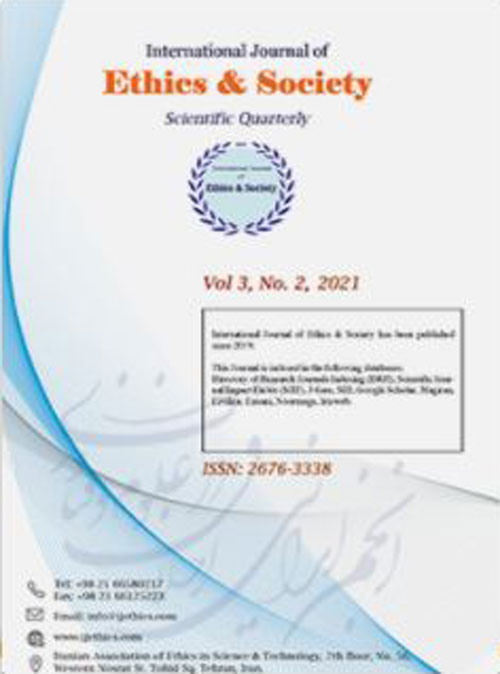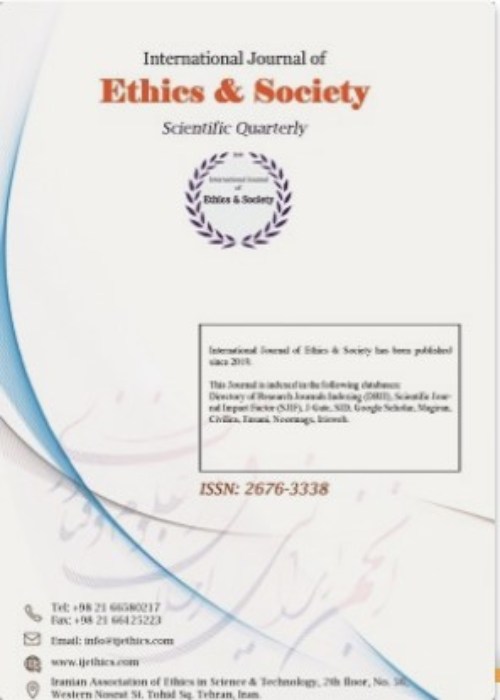فهرست مطالب

International Journal of Ethics & Society
Volume:3 Issue: 3, Autumn 2021
- تاریخ انتشار: 1400/08/26
- تعداد عناوین: 8
-
-
Pages 1-9Background
The present article tried to investigate the musts and the must-nots for translators. In other words, the present researcher did her best to take an analytic look at the principles of the free translation of literary texts from English to Persian.
MethodThe library-based descriptive data was collected from a variety of academic databases such as Google Scholar, Eric, and ISC from 1960 to 2021.
ConclusionAccording to the literature theoretically and analytically reviewed as well as the present researcher’s investigation, sixteen translators’ commitments were considered as the most significant commitments of the translators as follow: avoiding word for word translation, considering characters’ positions and gender, utilizing foreign words in a translated text, following the speech of the source text, being committed to society, re-translating a text, regarding an editor for the translated text, reviewing and revisiting a translated text, domesticating SL expressions and idioms, reading other works of the same author, consulting with dictionaries, glossaries and references, omitting and adding a word if necessary, expanding vocabulary, mastering SL and TL grammars, dividing SL long sentences into smaller ones in TL and vice versa, and considering the author’s point(s) of view. The findings of the present paper may have some theoretical and practical implications for the translation trainers and trainees as well as translation researchers.
Keywords: Source language, Target language, Transference of the message, Translator’s commitments, Translator’s maneuver -
Pages 10-18Background
The aim of the present research is to investigate the research outputs on ethics and technology from the perspective of teachers, based on Google Scholar, from 1983 to 2020.
MethodsThis applied and quantitative study used descriptive and bibliometric methods. The population and sample of the study were 1343 documents retrieved from Google Scholar between 1983 and 2020. Harzing’s Publish or Perish software was used to collect data. VOSviwer and SPSS software were used respectively for visualizing co-authorship network and statistical cases.
ResultsBased on findings, in the first 16 years only 84 documents were published; the number of publications during the next years steadily increased. About 64% of the papers were written by one author; while only less than 3% of papers had five or six authors. Also, Spearman correlation test showed that there was a significant and positive association between publication year with Google Scholar rank as well as between publication year and the number of authors per paper. The association between publication year and citation per author and publication year with citation was negative and significant. Furthermore, in the present study, the core authors based on co-authorship network and Collaborative Coefficient (CC) were identified.
ConclusionIn Google Scholar the new published papers are retrieved and placed in the first ranks. The number of citations per author and number of citations in total increased when the year of publication decreased. It seems the number of published papers is not reason enough to receive higher citation.
Keywords: Collaborative Coefficient (CC), Co-authorship networks, Ethics, Technology, Google Scholar -
Pages 19-27Background
Ethical principles applied in organizations can broaden individual and corporate priorities beyond profit and shareholder enrichment. Ethical factors may influence leaders to make sound decisions to protect the organization from unethical behavior. The present research seeks to investigate the effects of managers' professional ethics on decision-making strategies regarding the role of the capacity of information management systems capacity in the managers of Islamic Azad University, Mashhad Branch.
MethodThe present study is a descriptive-comparative study. The population in this study is determined to be a group of managers of Islamic Azad University, Mashhad Branch concluding 111 individuals. Data collection was conducted through questionnaires of professional ethics, decision-making strategies, and information systems capacity. The sample size was obtained utilizing the Cochran's formula and the data collection was performed using simple stratified random sampling method. SPSS and Smart PLS were used to analyze the statistics and the structural equation modeling method was used to answer the research hypotheses.
ResultsThe results showed that managers’ professional ethics has an impact on decision-making strategies, but information systems capacity does not modify the influence of managers’ professional ethics on decision-making strategies.
ConclusionProfessional ethics affects decision-making strategies at Mashhad Islamic Azad University. Therefore, observance of ethical issues in the organization, especially in dealing with managers with employees is a need and respect should always be considered so that the employees feel more committed to their work and organization.
Keywords: Professional ethics, Decision-making Strategies, Information systems capacity, Management -
Pages 28-35Background
Due to the prevalence of immoral behaviors, it is necessary to study ethical behaviors and identify its predictors with the aim of promoting ethical behaviors. Therefore, the aim of this study was to predict moral behavior based on psychological health, lifestyle and prosocial behaviors.
MethodThis was a descriptive-analytical correlational study. The study population of principals and deputies of the second year of high school in Tehran in the academic year 2009-2010 was 2973 people. The sample size based on Cochran's formula was estimated to be 340 people who were selected by multi-stage cluster sampling method. The research instruments were the Ethical Behavior Inventory, the Psychological Health Scale, the Health Promoting Lifestyle Profile, and the Prosocial Behavior Questionnaire. Data were analyzed by Pearson correlation coefficient and multiple regression tests simultaneously in SPSS software version 25.
ResultsThe results showed a significant relationship between psychological health (r = -0.35), lifestyle (r = 0.27) and societal behaviors (r = 0.41) with moral behavior (P <0.01). Other results showed the effective role of mental health, lifestyle and prosocial behaviors in predicting moral behavior (R2 = 0.39, P <0.001).
ConclusionAccording to the results of this study, planning to improve moral behavior based on psychological health, lifestyle and prosocial behaviors is essential.
Keywords: Morall behavior, Psychological health, Lifestyle, Prosocial behaviors -
Pages 36-43Background
Ethical marketing strategy based on position analysis, identifies market opportunities and by defining different market segments and identifying the strengths and weaknesses of the organization, enables competition conditions. Designing a marketing strategy is one of the most important tasks of business planning for publishing companies. This study provides a model for designing a mixed ethical marketing strategy in a children's book based on the parents purchase intention.
MethodThe research is applied in terms of purpose and descriptive-survey in terms of implementation method. The statistical population included the employees of cultural institutions that produce children's books. Sampling was done by simple random sampling and 110 people were selected as the statistical sample. The data collection tool was a mixed marketing ethics questionnaire and finally Friedman test was used to analyze and rank the data.
ResultsThe results finally led to a proposed model for explaining the C4 marketing mix strategy by highlighting the advertising element in line with the marketing strategy and the integration of the specific strategy of each mix.
ConclusionCommitment to ethics in marketing and business creates a kind of trust that is a social and valuable capital and guarantees the long-term success of the relevant enterprises.
Keywords: Ethical marketing, Marketing strategy, Children's book, Parent purchase -
Pages 44-52Background
Today, social responsibility plays an important role in the success and survival of organizations, also, moral attitudes have a significant impact on corporate social responsibility. Therefore, the aim of this study is to identify the relationship between moral foundations and perception of corporate social responsibility.
MethodThe present research is a descriptive study. The statistical population of this study is financial managers of the companies listed in Tehran Stock Exchange. The convenience sampling method is used to select the statistical sample. The research instrument includes two standard questionnaires of moral foundations and perception of corporate social responsibility. Finally, the data extracted from 240 questionnaires were analyzed using Structural Equation Modeling by Lisrel software.
ResultsThe results confirmed the existence of a positive and significant relationship between moral foundations and perception of social responsibility. In other words, any change in the variable of moral foundations changes all aspects of economic, legal, ethical, and philanthropic corporate social responsibility.
ConclusionImplementation of corporate social responsibility has many benefits for the society. Therefore, regulatory bodies and decision-making authorities should consider corporate mangers’ moral foundations as a factor affecting on corporate social responsibility.
Keywords: Ethics, Moral Foundations, Perception of Social Responsibility -
Pages 53-60Background
Job involvement is one of the most important ways to increase employee effectiveness by improving ethical climate and reducing social undermining. On the other hand, job involvement helps employees to be more committed to their work. The purpose of this study was to investigate the role of ethical climate and social undermining on job involvement of employees.
MethodsResearch method is applicable in terms of practical purpose and type of descriptive–correlation and stepwise regression. Among 292 employees of the general department of education of Lorestan Province, 169 were selected by relative stratified random sampling. In order to collect data, from three questionnaires of ethical climate, social undermining was used in job and job involvement. SPSS software was used to analyze data from descriptive statistical methods and Pearson correlation coefficient and stepwise regression.
ResultsThe results showed that ethical climate and its dimensions have a significant positive relationship with job involvement. 21.3% of the changes in job involvement of employees are influenced by 3 aspects independence and instrumental and regulation. Also, social undermining and its dimensions have a significant negative relationship with job involvement. 4.8% of job involvement changes are affected by the aspect coworker undermining.
ConclusionBased on research results of ethical climate and social undermining have an impact on job involvement and are considered as important variables associated with it.
Keywords: Job involvement, Ethical climate, Social undermining -
Pages 61-70Background
The purpose of this study is to investigate the role of customer clustering in the design of an ethical and targeted marketing model in Internet of Things (IOT) Technology Services Companies.
MethodThe research method is applied, exploratory and mixed (qualitative-quantitative). Qualitative section: 15 people of sales and marketing managers of IOT companies, were selected for in-depth interviews by targeted and snowballs methods. In this phase used entropy and VIKOR decision-making techniques. The software used in this phase was Max QDE. Quantitative section: In this phase, all the customers of the studied companies were included, and due to the unlimited nature of the society with Morgan's table, 384 people were selected as the sample size by non-random and available methods. The data collection tool in this section was questionnaire, which used Cronbach's alpha to examine the validity of the questionnaire. In order to analyze the data, the exploratory factor analysis method and Partial least squares structural equation modeling (PLS-SEM) with Smart-PLS2 and Liserl software were used.
ResultsQualitative section: In this phase, four clusters were identified: communication factors, ethical and behavioral factors, individual factors and economic factorsQuantitative section: In this phase, the model obtained in the first phase was quantitatively examined and validated and approved.
ConclusionThe results showed that four main clusters: communication factors, ethical and behavioral factors, individual factors and economic factors are dimensions of targeted marketing and customers are classified according to their characteristics. So, these companies should pay attention to these items as methods for sales promotion.
Keywords: Ethical targeted marketing, Entropy, VIKOR, Customer clustering, Internet of things


